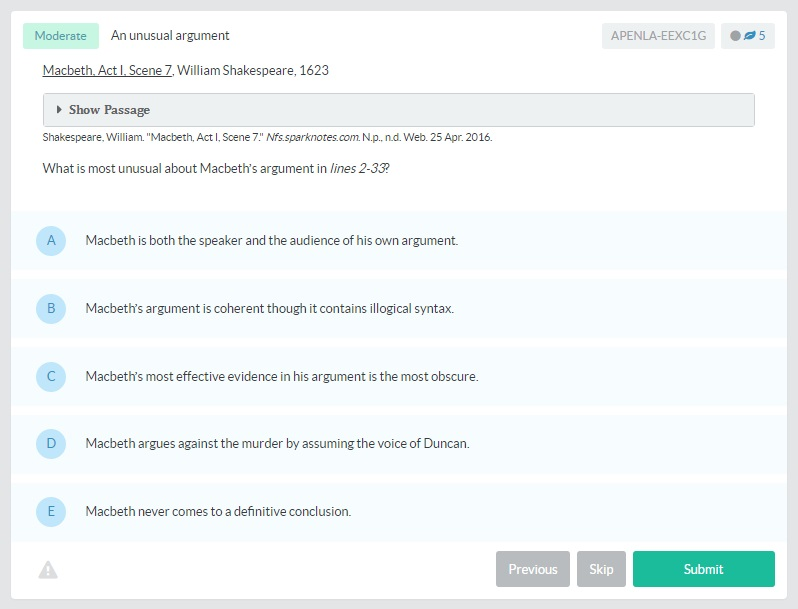The AP® English Language exam contains three essays and a multiple choice section. While some would say that it is impossible to prepare completely for this exam, there are easy-to-implement strategies that can raise your score. Listed below are eleven valuable test taking strategies for both the essays and the multiple choice questions.
The AP® English Language Free Response Questions

1. Understand Before Undertaking
Always read and fully understand the text before you begin your essay or you chose an answer. During the free response questions the students often rush through reading of the texts given in order to quickly formulate an answer or thesis. This results predominantly in a superficial reading, or even a misreading, of the text. For this reason, it is important to take the fifteen minutes given in order to fully read, comprehend, and process the deeper meanings within the text.
2. Quality Over Quantity
In the AP® English Language exam’s free response questions (FRQs), it is vital to support your argument. A strategy to do this is to incorporate supporting details; however, this strategy is specifically to choose supporting details that you can elaborate on. Too many details that are not as supportive to your argument will actually hurt that argument.
For example, if you overquote in your essay, then the question must be asked: does this student know what they are talking about or are they just piecing together others’ opinions?
Instead, the best strategy is to pick out three supporting details that you can focus on and develop. This will show the AP® English Language exam readers that you know how to appropriately utilize your information and can develop that argument. Since there are three essays that you have to argue your point for, this tip could vastly improve your score.
3. Write Outlines
Yes, the AP® English Language exam is timed, but this strategy of writing outlines can save you time in the long run. An outline for the essay forces you to make a plan that organizes your thoughts and gives your essay a natural progression. By utilizing this technique, your essays will have better flow, unity, and more uniformity than a student making it up as he or she goes.
So while every minute of the AP® English Language exam is precious, setting aside five to ten minutes to outline will help you formulate your ideas and churn out a great group of essays.
4. Do Not Summarize the Sources
During the synthesis essay of the AP® English Language exam it is important to use the sources in front of you for material. This does not mean that you should simply summarize the texts in your essay. This strategy is all about utilizing short quotations and paraphrasing. The reader does not need the entire text summarized; the reader has already read the supporting texts.
By summarizing the texts, or giving unnecessary context, the reader will have trouble finding your argument, making your essay less clear overall. So be sure to explain why the source is important to your argument, but do not summarize.
5. A Quick Introduction
As the free response questions are timed, a great strategy to use is to have quick introductions that get right to the thesis, or argument. This will minimize unclear introductions that will confuse the reader. Get right to your point and start supporting it.
This is especially useful if you have trouble beginning an essay of any kind. By writing down your thesis and quickly getting to the point, then you do not have to spend lots of time choosing exactly how you should construct it. Here simplicity is king.
6. Write the Introduction Last
If you are still struggling with writing the introduction, then you can leave a few lines blank at the top of your essay and jump right into the body. This will allow you to write your essay without stopping to change your introduction, because sometimes your ideas may change as you write the paper. When you return to those blank lines at the top you just have to quickly introduce everything you just wrote and jot down your thesis.
By waiting until you have constructed the body of your essay, you understand your essay much better than at the beginning. There is, however, some danger in doing this. If you do not keep track of your time, then you may end up with a paper without an introduction. This may not be that big of a deal unless you have not written your thesis statement anywhere else in the paper, because your argument should be stated clearly.
7. Do Not Define Terms for the Reader
Your readers are highly trained examiners that know what rhetorical devices are. Because of this, you do not need to define the terms that you are using, no matter how abstract or complicated they are.
A strategy to follow with terms you use in the AP® English Language essays is to use the term, explain how that term is used by the author, and explain why it is important. By doing this you respect your reader’s knowledge base and bring a more sophisticated, analytical look at the texts or prompt.
8. Avoid Clichés
We are all guilty of using clichés, but they do not belong in your AP® English Language exam. When crafting your essay, or revising at the last minute, comb your writing for overused, tired phrases. They make your argument seem tired as well.
If you have a habit of using clichés, then a great strategy for you is to change a cliché to make it fresh and tailor it to the argument. This will give clarity to your point, and it will make your paper stand out. Be sure to avoid strange alterations of clichés that do not relate to your paper. These will lose points.
Strategies for the AP® English Language Multiple Choice Section

The multiple choice section is 52-54 questions that make up 45% of your overall score. There are strategies that will greatly increase your ability to excel on multiple choice exams; however, the best strategy is to practice frequently. Taking practice tests months before the AP® English Language exam will get your brain ready and help you to train yourself how to think.
9. The Art of Guessing
The AP® English Language exam is not an easy exam; therefore, there will be a few questions that you will have no idea how to answer. Because the AP® English exam does not take away points for a missed answer, you are advised to guess. A strategy to guess well is to eliminate any choices that seem completely wrong.
Usually there will be two choices that look possible and two that do not, so narrow it down to those two. With these two choices in mind, read the passage again. This will focus your mind on comparing the two choices and help you reach a conclusion. Although, do not debate with yourself for too long. This is a timed test after all!
10. Managing Time
In any timed test, time management is important. In the AP® English Language exam, you must be careful and cognizant of where you stand in your booklet and in time. A great way to do this is to look up at the clock after every five questions that you answer.
This will keep you on track and allow yourself to keep a steady pace. You will need to continually change your pace as you work in order to overcome the longer questions that contain prose, but if you do not zone out or get stuck on a question, then you will do great.
11. Read the Questions First, Not the Answers
An age old-trick is to read the multiple choice questions and answers before you do the reading. This can be helpful in some instances, but the AP® English Language exam has answers that are made to trick you. Because of this, you will want to read the questions first to focus your thinking, but do not read the answers until you have read the text.
This allows your thinking to be unpolluted by the choices, and you do not convince yourself that an incorrect answer is correct.
Key Takeaways
So on test day be sure to keep calm and follow these strategies. You have prepared well and you will do great, especially if you keep in mind that the AP® English Language exam is graded depending on how your peers do as well. Therefore, by reading this article you already have a leg up on them! Just remember to read critically, quote when needed and not more, use your outline, stop yourself from summarizing the sources, write a quick introduction last, avoid clichés as well as defining terms for the reader, eliminate answer choices, manage your time well, and always read the questions first. If you do all of these, then you will do fine.
References:
Let’s put everything into practice. Try this AP® English Language practice question:
Looking for more AP® English Language practice?
Check out our other articles on AP® English Language.
You can also find thousands of practice questions on Albert.io. Albert.io lets you customize your learning experience to target practice where you need the most help. We’ll give you challenging practice questions to help you achieve mastery of AP® English Language.
Start practicing here.
Are you a teacher or administrator interested in boosting AP® English Language student outcomes?
Learn more about our school licenses here.









